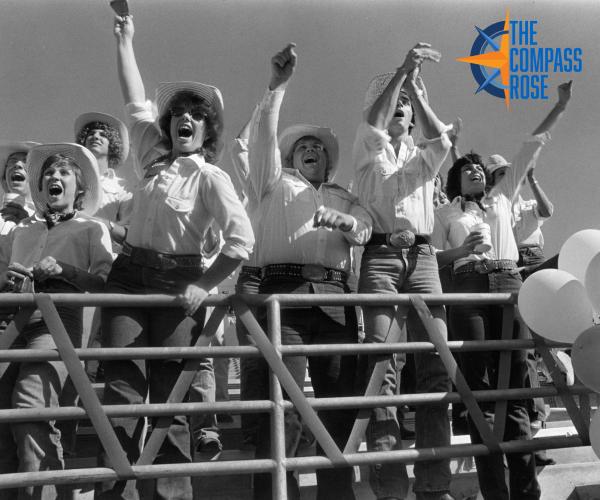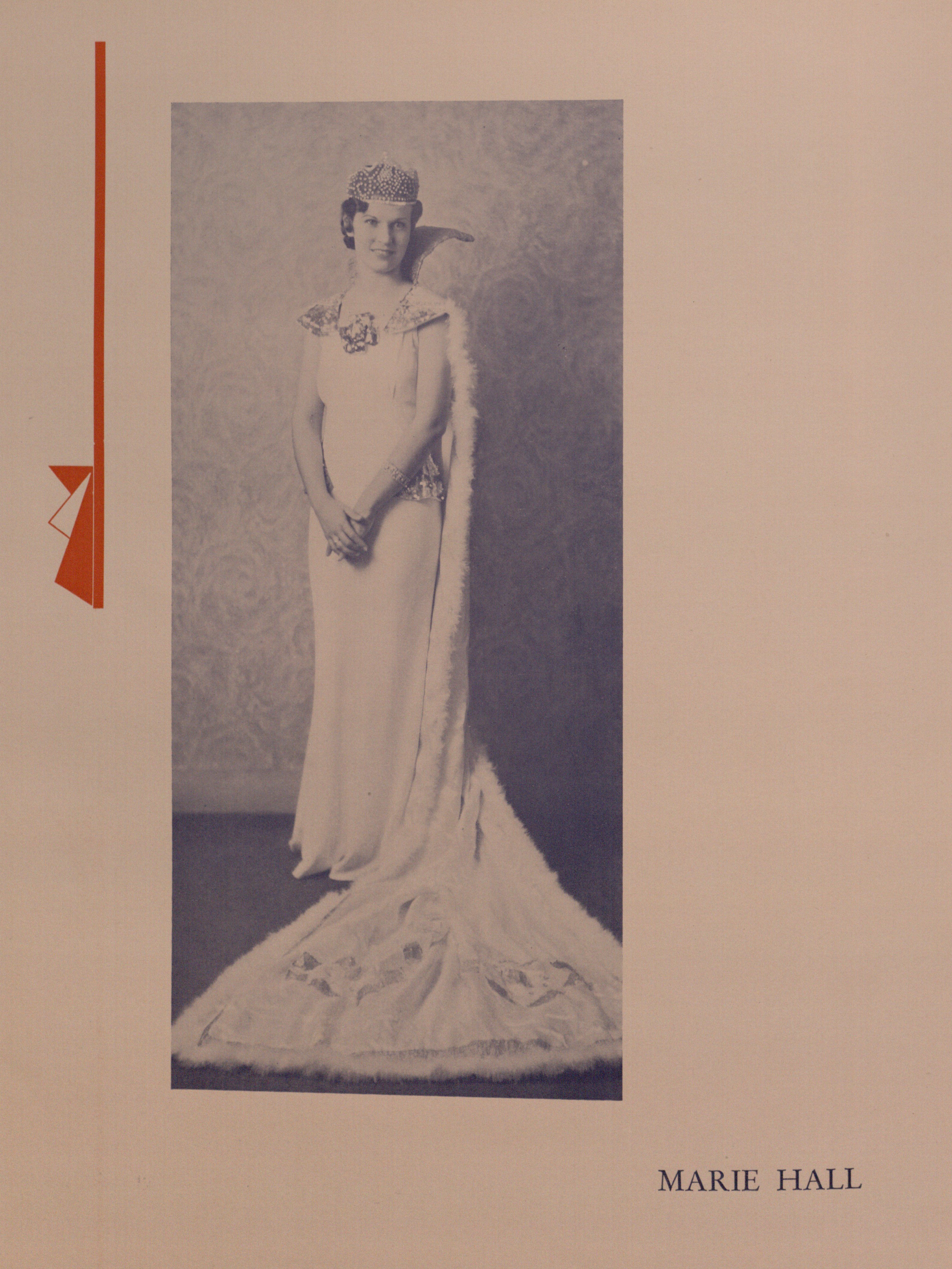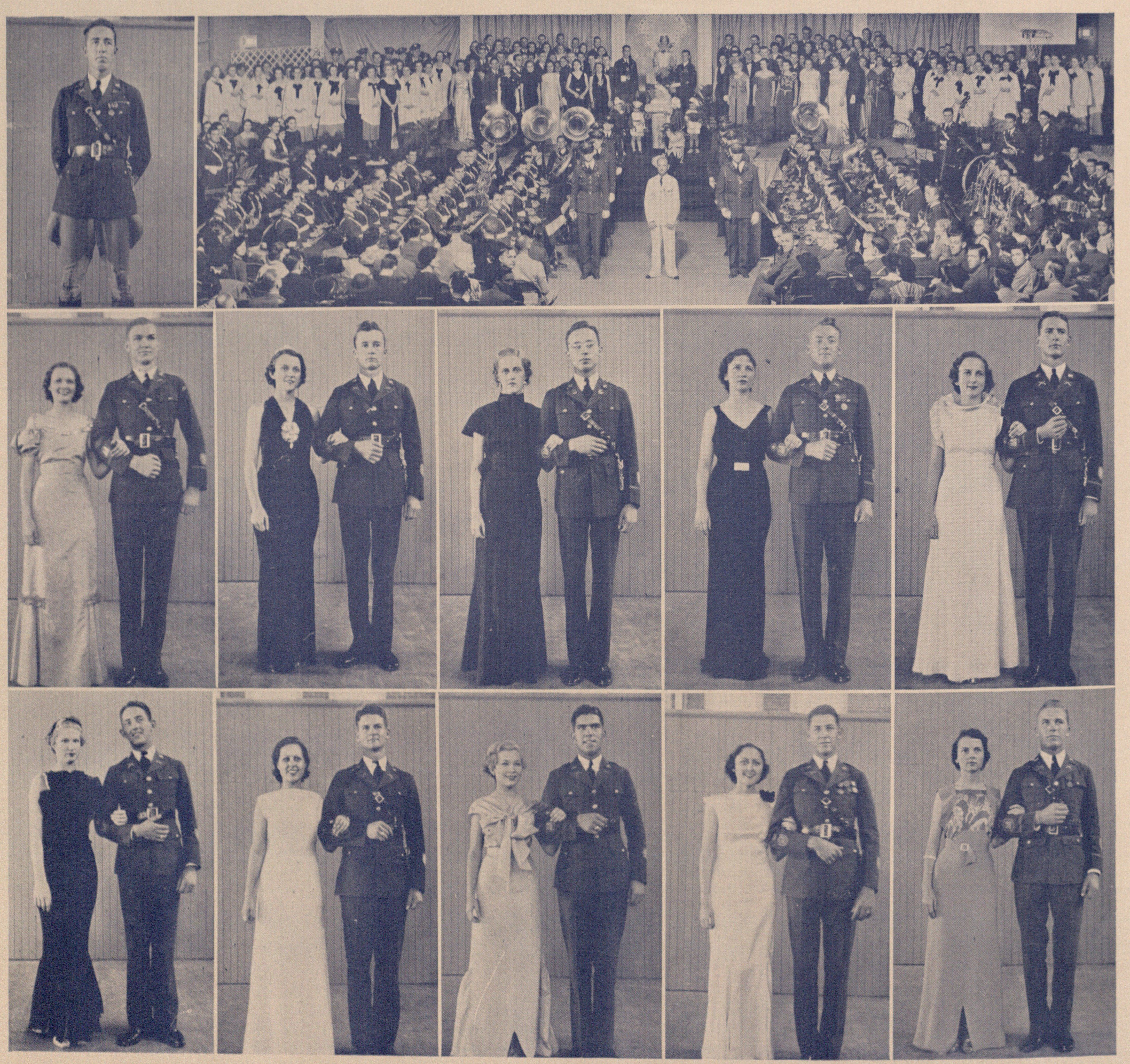
by Michael Barera


by Michael Barera
The purpose of The Compass Rose is to raise awareness of Special Collections' resources and to foster the use of these resources. The blog series also reports significant new programs, initiatives, and acquisitions of Special Collections.
Homecoming is one of the longest-standing and most important traditions at UTA. Although the name "homecoming" was not used until 1953 and the event has evolved considerably over the years, homecoming on campus traces its history back to 1934-35, when the first homecoming court was crowned. It was first scheduled around a football game and then, after UTA dropped football in 1985, around a basketball game. Some events, like the homecoming parade and the crowning of the homecoming court, are still vital parts of UTA's homecoming, while others, like the Blue and White Fashion Show and the Big Switch, are now defunct. In celebration of homecoming at UTA occurring next week, the following is a brief history of the event.

Marie Hall, “Her Majesty, Queen of the 1934-35 Student Body” at North Texas Agricultural College.

Composite of photos of members of the 1934-35 coronation court.
The earliest documented homecoming court at what is now UTA occurred in 1934-35, when the school was known as North Texas Agricultural Collect (NTAC) (Quillen). The term "homecoming" was not yet used at the time, however, as Marie Hall was crowned "Her Majesty, Queen of the 1934-35 Student Body" (1935 Junior Aggie yearbook). At NTAC, the homecoming court consisted of a king, queen, princess, and escorts, and was elected by the student body (Saxon 1995, 72). NTAC typically played a football game against John Tarleton Agricultural College (JTAC, now Tarleton State University) in Stephenville as part of homecoming festivities. Both schools were members of the Texas A&M University System at the time, and both held Aggie Bonfires and pep rallies before the game. According to a long-standing tradition, students from both NTAC and JTAC attempted to prematurely light the other school's bonfire every year, which culminated in an unsuccessful attempt by two NTAC students to drop phosphorus bombs from an airplane to ignite the JTAC bonfire in 1939. The attempt ended in a crash landing and hazing of the NTAC students by JTAC students, after which NTAC canceled its annual homecoming bonfire (Saxon 1995, 71; Guthrie).
By the 1950s, the homecoming bonfire tradition had returned to campus, and the bonfires were held on a large field near Fielder Road and Mitchell Street (Quillen). 1953 was the first year that the word "homecoming" was used to describe the event at what was then Arlington State College (ASC) (Kwarteng). In 1962, a Tarleton State student prematurely lit ASC's homecoming bonfire. In response, students living in Pachl Hall and Brazos House stood watch over the unlit bonfire day and night during homecoming week in 1963, and even brought a field telephone with them so they could call both dormitories in the event of an incursion by a Tarleton student (Crane). According to Kent Gardner, who arrived on campus as the assistant to the dean of students in 1967, the bonfires attracted over 10,000 people. They were lit on the Friday night of homecoming week, before the football game on Saturday. Gardner explained that "students would spend that whole week building the bonfire," even camping at the site in tents and campers (Quillen). In 1977, the bonfire was created from 185,000 pounds of wood and, after it was lit, a free rock concert was held at the site (Basnet).
During the 1960s, homecoming at ASC was observed as "Old South Week," which included Confederate iconography and even mock slave auctions (Saxon 1995, 113). During this era, the college's nickname was the Rebels, and a "Miss Dixie Bell" and "Johnny Reb" would be elected as part of the festivities. Then-University Archivist Claire Galloway noted that for much of the early history of the school, coronations coincided with football games, while class reunions typically coincided with graduations. Galloway elaborated that homecoming became "much more coordinated and organized" after ASC became a four-year college in 1959 (Quillen). For many years, parades were a significant part of homecoming, and they featured floats made by student organizations and marching bands and ROTC drill teams from around North Texas (Quillen).
ASC was integrated in July 1962 (Saxon 1995, 87–88) and was renamed the University of Texas at Arlington (UTA) in 1967 (Saxon 1995, 100). In 1980, Wanda Holiday became UTA's first African American homecoming queen while Rodney Lewis, also an African American student, became its first-ever homecoming king (Barker & Worcester 2015, 96; Saxon 1995, 119). By the late 1970s, homecoming events at UTA included the bonfire, bed races, a homecoming dance, and a pep rally (Kwarteng). After UTA dropped its football program in 1985, it moved homecoming from the fall football season to the spring to better align it with basketball season (Barker & Worcester 2015, 111; Crane; Quillen). In 2012, UTA moved homecoming back to the fall (Barker & Worcester 2015, 111; Vuppula).
In 1988, homecoming featured an alumni art exhibit, various alumni receptions, a volleyball game, UTA Freewheelers wheelchair basketball game, pep rally and cookout, fashion show, bike rally, tennis tournament, pre-game barbecue, exhibition basketball games, UTA Dance Ensemble performance, and a Homecoming Awards Ceremony and Dance (Vertical File Material on Homecoming).
By 1996, the core events at UTA homecomings were men's and women's basketball games, crowning of the homecoming king and queen (typically during halftime of the men's game), Movin' Mavs wheelchair basketball games, the Blue & White Fashion Show, and the Military Science Hall of Honor ceremony. Patricia O'Neill, director of special projects for UTA's Student Development department at the time, described the Blue & White Fashion Show as evolving from a "real showing of spirit for UTA" into an event more focused on the latest styles in fashion (Crane).
In 1998, homecoming featured a wide variety of events, including baseball games, a fashion show, various alumni reunions, men's and women's basketball games, a pep rally, the Military Science Hall of Honor induction ceremony, and coronation of the homecoming queen and king at halftime of the men's basketball game (Vertical File Material on Homecoming).
In 2003, homecoming featured a pep rally, an improv comedy show, a fashion show, the Blue & White Bash, and men's and women's basketball games. In addition to this, it also included a performance by actor and comedian Jamie Kennedy (known at the time for The Jamie Kennedy Experiment) and a screening of the film 8 Mile (Vertical File Material on Homecoming).
In 2011, homecoming events included a golf-cart parade, tailgate, chili cook-off, step show, and The Bash, which featured food, games, and other activities. By that year, the Blue and White Fashion Show and the Big Switch (an event that allowed UTA students and administrators to switch places for a day) had become defunct (Kwarteng).
In 2017, homecoming consisted of over 30 separate events. Among the most notable were basketball games, a street festival, a parade, a pep rally, a 5K race, and the coronation of the homecoming king and queen, which took place during halftime of the men's basketball game (Basnet).
Homecoming 2021 is taking place next week, November 8 to 14 ("Homecoming"). Events include the Homecoming 5K Run/Walk/Roll (with all proceeds going to the UTA Emergency Assistance Fund), a chili cook-off, golf tournament, basketball games, parade, street festival, and The Bash ("Events").
Barker, Evelyn; Worcester, Lea (2015). University of Texas at Arlington. Charleston, South Carolina: Arcadia Publishing.
Basnet, Neetish (Nov. 8, 2017). "Homecoming traditions change but spirit remains." The Shorthorn.
Crane, Allen (Feb. 8, 1996). "Homecoming rooted deep in tradition." The Shorthorn.
"Events." University of Texas at Arlington Student Affairs. Retrieved October 28, 2021.
Guthrie, Chris. "The Bonfire Incident." Tarleton State University. Retrieved November 1, 2021.
"Homecoming." University of Texas at Arlington Student Affairs. Retrieved October 28, 2021.
"Homecoming 1965." UTArlington Magazine. Winter 2012. Retrieved October 29, 2021.
Junior Aggie. 1935.
Kwarteng, Tesia (Feb 21, 2011). "UT-Arlington offers old and new traditions for alumni and students." The Shorthorn.
Saxon, Gerald D. (1995). Transitions: A Centennial History of the University of Texas at Arlington, 1895–1995. Arlington, Texas: UTA Press.
Quillen, Alanna (Feb. 10, 2009). "UTA's Homecoming past remembered including its football days, bonfires." The Shorthorn.
Vertical File Material on Homecoming at the University of Texas at Arlington, Special Collections, The University of Texas at Arlington Library.
Vuppula, Hannah (July 3, 2012). "UTA Homecoming moves to the fall." The Shorthorn.
Add new comment